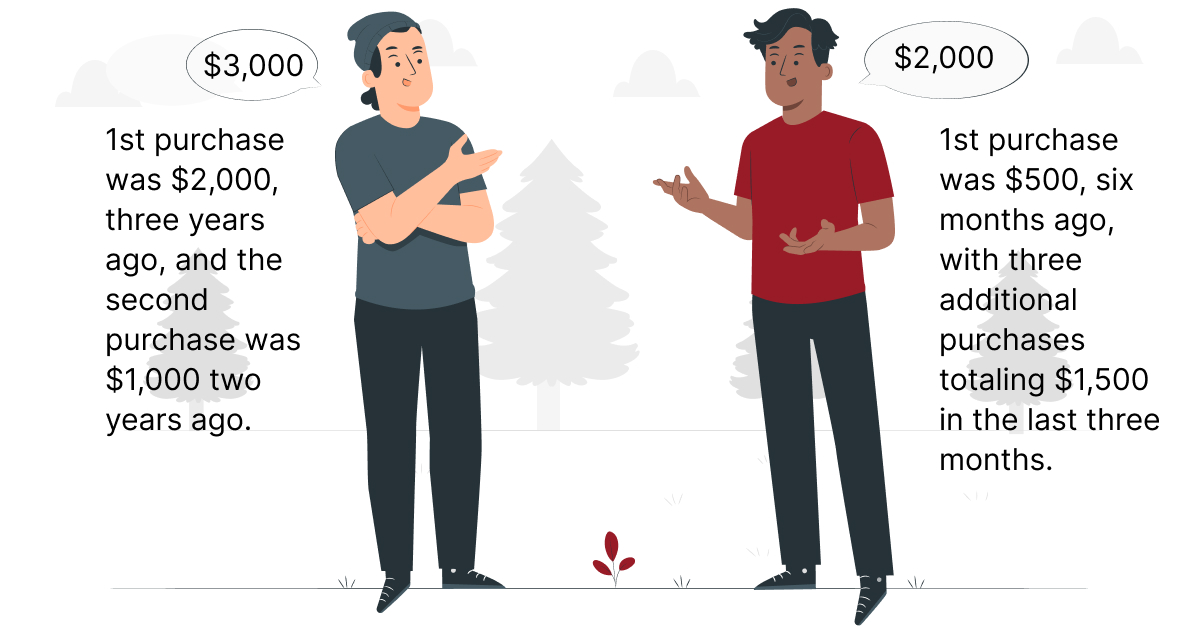Author:
James Hipkin
Publish Date:
July 24, 2020
RFM Analysis is a customer segmentation technique that helps businesses identify valuable customers based on their spending behavior.
I was first exposed to RFM analysis early in my career in direct marketing. It’s an analysis technique that catalog marketers developed to minimize marketing expenses and maximize the return on ad spent (ROAS).
Using consumer behavior to determine segmentation allowed catalog marketers to send personalized campaigns to the customers most likely to purchase again. Direct mail marketers further refined RFM modeling and confirmed that RFM segment marketing works. They use RFM factors to predict future consumer purchasing behavior and develop effective direct mail marketing strategies.
This article will explain the RFM analysis method and how marketers can use RFM segmentation to optimize RFM marketing campaigns.
Key Takeaways
- RFM meaning: RFM is an acronym for Recency, Frequency, and Monetary Value
- RFM analysis is an efficient way to identify your Best Customers
- RFM can be used to focus marketing and loyalty efforts on the customers who are most valuable to the business
- the RFM customer list also tells you what category Best Customers (prospects) look like
RFM is a market research technique based on the idea that the customer who bought from you most recently, who buys from you most frequently, and who spends the most money with you is the customer most likely to buy again.
As mentioned above, RFM segmentation was first used by direct mail, non-profit, and catalog marketers. RFM data analysis was used to segment and target customers with the best RFM score. These most valuable customers are the customers most likely to buy again. This could be repeat purchases, a donation, or another purchase from the catalog. It could also be a cross-sell or an up-sell. The reasoning behind the practice is simple – people who donated or bought from you in the past are likely to buy or donate again.
What is RFM Analysis?
RFM segmentation uses raw data to identify the customers delivering the most value by analyzing their own purchase history and behavior. As suggested above, RFM uses three data points:

- Recency: The number of days since a customer’s last purchase.
- Frequency: The number of purchases a customer makes over a specific period.
- Monetary Value: The total amount of money a customer spends over a specific period.
The RFM segmentation model uses these three factors to segment customers into different groups based on their spending behavior. Businesses can analyze customer behavior and then use RFM segmentation, especially monetary values, to create marketing campaigns that target high-value customers to improve retention and sales.
RFM analysis is a proven technique used to identify high-value customers that are more likely to convert, which means more effective Digital Marketing. Share on XSegmenting Customers Using RFM
Why Identifying Best Customers Matters
For virtually every business, profitable growth is driven by the best customers. This is another example of Peretto’s Principle. When you analyze revenue, you will find that 80% of sales are coming from 20% of your customers. Your specific ratio may vary, but the principle is sound.
These best customers are heavy category users. They have a significant need for what you are selling. They are also knowledgeable. They understand your products and services, and they understand what your competitors are offering. Accepting this will impact your messaging.
A business needs to maintain these customers and attract more just like them. This is why RFM segmentation is so useful. It identifies best customers and lets the business communicate with them in ways that bring value.
To clarify this idea, consider two customers. One spent $3,000 with you, and the other spent $2,000 with you.
Which one is a ‘best customer?’
As the illustration shows, the second customer, the one who spent $2,000, is actually the best customer and the customer you should focus on. The second customer purchased from you recently, and their spending is increasing. The first customer purchased from you years ago, and their spending declined.
Marketing to the second customer with information about your current offers is much more likely to have a positive ROI. The first customer may be worth some effort, but before this happens, you need to understand why they stopped buying from you. The best marketing in the world won’t change a customer’s need state.
How to Identify Best Customers Using RFM Analysis
The first step to implementing the RFM segmentation process is to gather customer data. This data can be collected from a customer database that contains information on customer transactions and historical data. It’s especially easy for an e-commerce business to perform RFM segmentation, but most businesses can find the data that’s needed.
Once the data has been collected, you can calculate RFM metrics. This involves scoring each customer on a scale of 1 to 5 for each of the RFM values for recency, frequency, and monetary value.
The customers are then segmented using the model, and each group of ranking customers is assigned a label. For example, customers with a high RFM score are labeled “best customers,” while customers with low scores for all three factors are labeled “other customers.”
Depending on your business, you may want to weigh the values to determine the RFM scores. For example, ‘monetary value’ may be more important than the frequency score or the recency score. How you weigh the RFM metrics will depend on your business objectives.
How to run an RFM Analysis Using Excel
David Langer published this tutorial on YouTube explaining how to use Excel to perform your RFM analysis. He mentions several times how easy it is. Your mileage may vary.
RFM Analysis Use Cases – Digital Marketing
Businesses can use RFM segmentation data to identify their loyal customers, repeat customers, and new customers. Each segment can be treated differently, which will improve the overall impact of marketing. Investing in marketing won’t change a customer’s need state. If they don’t need what you are selling, your marketing isn’t going to change this. However, a repeat customer has a demonstrated need for your services, so an investment in marketing to this group will result in value for both parties. Equally, a new customer will appreciate being acknowledged. The second relationship marketing principle is “The most crucial time is the beginning.”
RFM analysis can also predict future behavior. The customer group who bought from you most recently, who buys from you most frequently, is the customer who is most likely to buy from you again. Basically, digital marketers can use the RFM segments to target marketing campaigns and tailor messaging and offers to fit their needs.
For example, RFM segments are especially effective for email marketing loyalty programs. Customers with a high RFM score are more likely to generate sales, so increased loyalty is very important to the highest-paying customers. They are heavy users, which means the products and services they purchase from your business are important to them. Good customers expect to be rewarded, so additional information about how they can use their purchases will be seen and valued.
New customers can be targeted with appropriate messaging, but if the RFM model doesn’t award them a high RFM score based on their purchasing behavior and past purchases, they will stop receiving marketing.
Changes in customer behavior can also be tracked using the RFM model. If a customer drops out of the top quintile of monetary values, this can trigger an email with an attractive offer. Equally, if a customer joins the top quintile, a special message can be sent to them to enhance their monetary value further.
A digital marketer can also use RFM to identify their best customer segment and then use this file to create look-alike audiences for Social Media Advertising or Google ads. Ads targeting high-value customer segments will perform better.
RFM analysis use cases become obvious once you have the data.
Customer Segmentation – An RFM Use Case
Suppose a business wants to target its marketing efforts toward its most valuable prospects. In that case, they can use RFM analysis to identify who among their existing customer base has a high RFM score and create a targeted marketing campaign for this audience.
To do this, the customer communications business would use RFM analysis to segment its existing customers based on their RFM score (recency, frequency, and monetary value score) and identify the customers with the highest RFM score.
The business could mine customer data platform then create a targeted marketing campaign for these customers, such as a loyalty program. By doing so, they can increase customer loyalty, leading to increased revenue and profitability.
Caveat Emptor

Although RFM calculations and analysis are useful tools, they do have their limitations. For example, a business should avoid over-soliciting customers with the highest rankings. Use the 70:20:10 rule; 70% of your content is designed to create value for customers, 20% is curated content that your customers will value, and 10% is product- or sales-oriented.
Conversely, marketers should remember that consumers with lower RFM scores, while they shouldn’t be ignored, are unlikely to ever be great customers. They simply don’t need your product as much as your best customers.
RFM analysis helps identify these customers, too. They will be the majority of your customers, but they don’t represent the majority of customer lifetime value, so don’t spend your budget on them. All the marketing in the world is not going to change how much or how often they need your product.
By focusing on your best customers, you will maximize the ROI of your digital marketing budget. Spend less to reach the folks who matter and reap the rewards when they spend more with your business.
RFM Analysis – FAQs

RFM analysis is a data-segmentation technique used by businesses to sort customers based on their spending behavior and target segments with relevant marketing. The analysis is based on three main factors: recency, frequency, and monetary value.
RFM customer segmentation analysis works by scoring each customer on a scale of 1 to 5 for each of the three factors: recency, frequency, and monetary value. The customers are then segmented based on their RFM scores and given a label. Businesses can use this customer segmentation to identify loyal customers, repeat customers, and new customers.
RFM analysis provides businesses with a range of benefits, including identifying the best customers, predicting future customer behavior, tailoring marketing strategies, and creating targeted marketing campaigns to improve customer satisfaction, increase customer loyalty, and boost revenue and profitability.
To collect data for RFM modeling, you will need a customer database that contains information on customer transactions and historical data on customer journeys. Once the data has been collected, you can calculate the RFM metrics and segment customers based on their scores.
Yes, RFM analysis can be used for any business that collects customer data. It is particularly useful for businesses that have a large customer base and want to create targeted and personalized marketing strategies and campaigns based on an RFM model to improve customer retention and loyalty.
Conclusion – RFM Analysis and Digital Marketing
RFM analysis is a powerful customer segmentation technique businesses can use to identify valuable customers based on recency, frequency, and monetary value of purchases.
Then, the resulting RFM segmentation can be used to create targeted marketing campaigns.
Using this method, businesses can segment customers based on their spending behavior and create campaigns that focus on each segment’s specific needs and worth. Active, engaged customers receive current information about your products and services. Less valuable and lapsed customers receive limited marketing that’s focused on nurturing.
To get the most out of RFM analysis, businesses need to ensure they have accurate data and understand how to use it effectively. By doing so, they can improve customer satisfaction, increase customer loyalty and customer engagement, and ultimately boost revenue and profitability.
The Ultimate Guide to Creating a Profitable Online Course
Create and sell online courses. Learn how to use your knowledge to transform lives and earn income.
Mastering Mid-Funnel Marketing
Learn how mid-funnel marketing supports the buyer’s journey to conversation and improves customer lifetime value.
How to Craft a USP for a Business Like Yours
Learn how a USP that’s unique, clear and compelling breaks through the noise.
Author: James Hipkin
Since 2010, James Hipkin has built his clients’ businesses with digital marketing. Today, James is passionate about websites and helping the rest of us understand online marketing. His customers value his jargon-free, common-sense approach. “James explains the ins and outs of digital marketing in ways that make sense.”
Use this link to book a meeting time with James.



